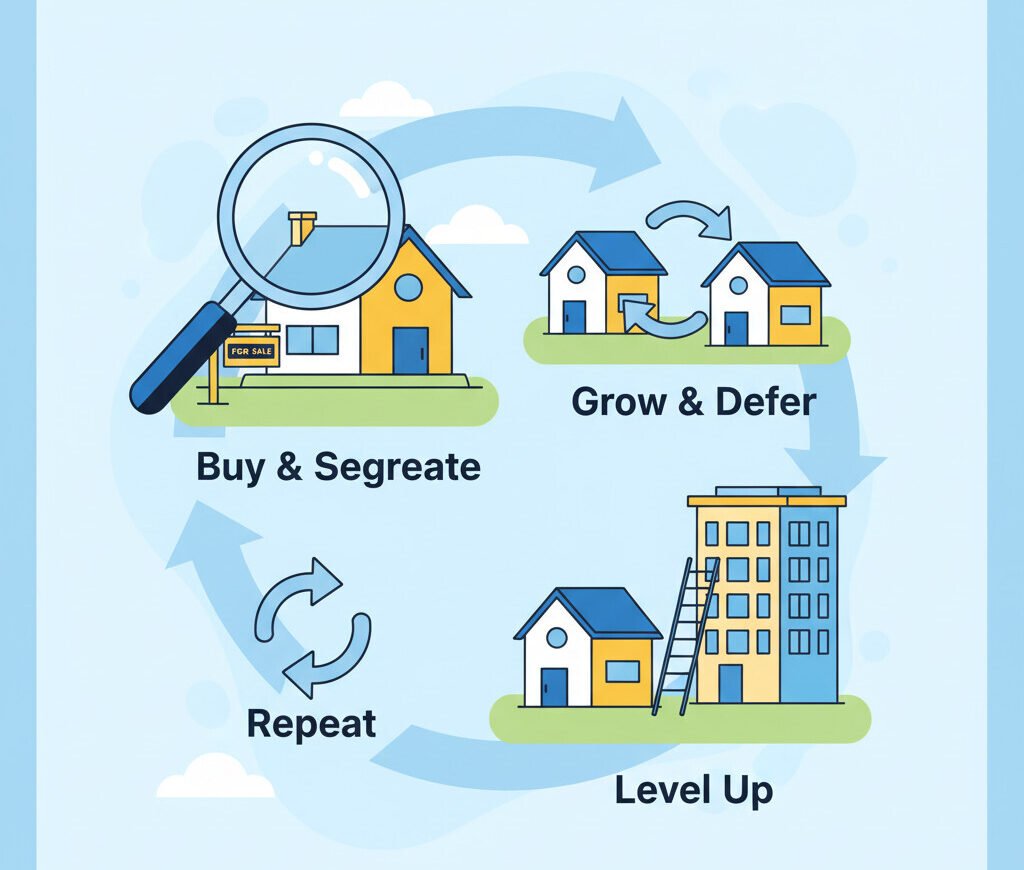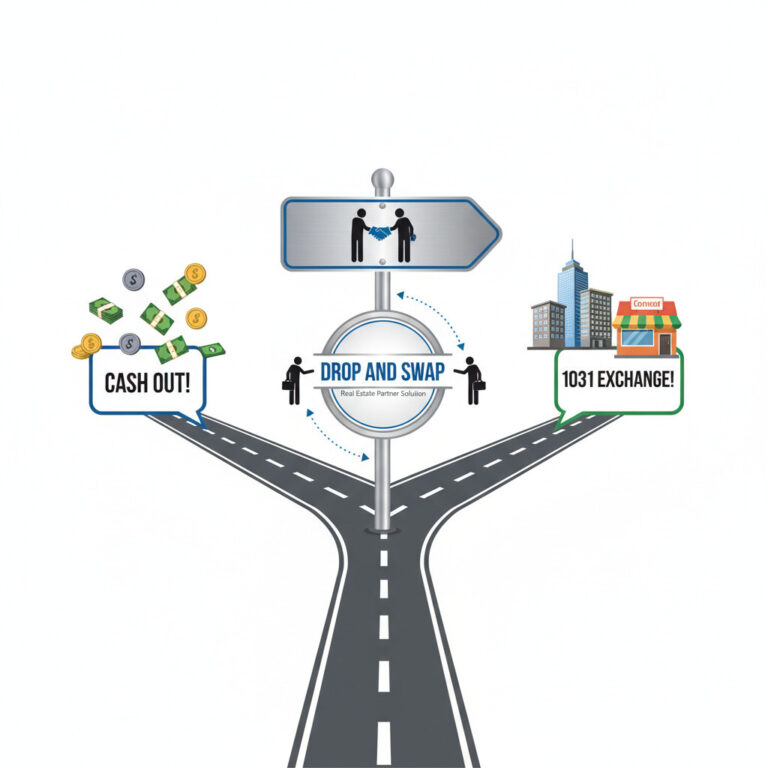The Real Estate Investor’s Tax Playbook: A Guide to Cost Segregation & 1031 Exchanges
For most people, taxes are the single biggest drag on their investment returns. But what if I told you there’s a whole playbook for real estate investors that completely changes the game? What if your investment property could not only pay you in cash flow and appreciation but also actively lower your income tax bill from your day job? It’s not a fantasy; it’s a set of powerful, legal tax strategies that the wealthiest investors use to build their portfolios. Ready to learn the plays? Let’s dive in! 😊
Play #1: Maximizing Deductions with “Paper Losses” 🤔
The first and most fundamental play in the book is all about creating massive, strategic deductions while you own the property. We’re talking about creating “paper losses”—these aren’t real cash losses from your bank account, but rather powerful, on-paper deductions you can use to offset your other income (like your salary). The cornerstone of this entire strategy is a concept called depreciation.
Depreciation is the IRS’s way of acknowledging that buildings and their components experience wear and tear over time. To account for this, they allow you to deduct a portion of your property’s cost each year over its “useful life.” The best part? It’s a non-cash expense. This means you get a real tax deduction that lowers your taxable income without having to spend any actual money.
Standard depreciation is incredibly slow. The IRS makes you spread the deduction for a residential property over 27.5 years. This results in a very small annual deduction, which doesn’t help much. But what if you could accelerate it?
Supercharging Your Deductions with Cost Segregation
This is where the magic happens. A powerful strategy called Cost Segregation allows you to turbocharge your depreciation deductions. It’s an engineering-based study that “unbundles” your property into its various components. Instead of treating the whole building as one big asset that lasts 27.5 years, it identifies and separates parts that have a much shorter useful life, like carpets, appliances, light fixtures, and landscaping (e.g., 5 or 15 years).
By reclassifying these items, you can deduct their costs over a much shorter period, creating massive paper losses in the early years of owning the property.
📝 Example: The Power of Cost Segregation
Imagine you buy a $500,000 investment property. A cost segregation study finds that $150,000 of its value is tied up in 5-year components. Let’s see how your first-year deduction changes with different methods:
| Depreciation Method | First-Year Deduction (Approx.) | Description |
|---|---|---|
| Standard Depreciation | $5,500 | The slow, default method over 27.5 years. |
| Cost Segregation | $30,000 | Accelerates deductions on short-life assets. |
| Cost Segregation + Bonus Depreciation | $120,000 | A special rule allowing you to deduct a large percentage of certain assets immediately. |
As you can see, using cost segregation with bonus depreciation can generate a paper loss of $120,000 in the first year alone. This massive loss can be used to offset your other income, potentially saving you tens of thousands of dollars in taxes.
Play #2: The Tax-Free Swap (1031 Exchange) 🔄
You’ve generated huge tax savings while owning the property, but what happens when it appreciates in value and you decide to sell? This brings us to the second legendary play in the book: the 1031 Like-Kind Exchange.
Named after Section 1031 of the tax code, this rule is a game-changer. It allows you to sell an investment property, take all the proceeds (including your profit), and reinvest them into a new “like-kind” investment property. By doing this, you can legally postpone paying 100% of the capital gains tax.
To successfully execute a 1031 exchange, you must follow two critical deadlines:
- Identification Period: You have 45 days from the date you sell your property to formally identify potential replacement properties.
- Closing Period: You must close on the new property within 180 days of the original sale.
Is It Always 100% Tax-Deferred? The “Boot” Traps
This is a crucial question. The answer is no; it’s not always 100% deferred. There are two common traps related to cash and debt, known as “boot,” that can make part of your gain taxable immediately.
| Type of “Boot” | Description | Tax Consequence |
|---|---|---|
| Cash Boot | This occurs if you don’t reinvest all the cash proceeds from the sale into the new property. | Any cash you keep is considered a taxable gain. |
| Debt Relief (Mortgage Boot) | This happens if the mortgage on your new property is smaller than the mortgage you had on the old property. | The difference in debt is considered “debt relief” and is treated as a taxable gain. |
To fully defer all taxes, you must follow two golden rules: reinvest all your cash and take on equal or greater debt.
The Ultimate Wealth-Building Cycle 📈
This is where it all comes together. Cost segregation and 1031 exchanges aren’t just separate tricks; they fit together perfectly to create a powerful, repeatable cycle for building generational wealth. This isn’t just about saving some tax in one year; it’s about creating an engine to compound your net worth.
The 4-Step Wealth-Building Cycle
- Buy & Segregate: Purchase an investment property and immediately use a cost segregation study to generate huge upfront tax deductions.
- Grow & Defer: After the property appreciates, sell it and use a 1031 exchange to defer 100% of the capital gains.
- Level Up: Use all of your untaxed proceeds to acquire a bigger, better, or more profitable property.
- Repeat: Continue this cycle over and over, compounding your wealth with the government’s money (via deferred taxes).
The Endgame: Erasing a Lifetime of Gains with Step-Up in Basis
You might be thinking, “Aren’t I just kicking the tax can down the road?” Yes, but that’s a massive win. Deferring tax allows you to reinvest money that you would have otherwise paid to the government, essentially giving you an interest-free loan to grow your portfolio faster. But the true endgame is even more incredible: the step-up in basis.
If you continue this cycle and hold onto your properties until you pass away, your heirs inherit them at their current fair market value at the time of your death. Their “cost basis” is “stepped up” to this new value. The result? All of the deferred capital gains you accumulated over your entire life can be completely and legally wiped out, gone forever. Your heirs can then sell the properties and owe little to no capital gains tax.
Conclusion: A Word of Caution ⚠️
Before you rush off to execute this playbook, it is absolutely vital to understand that these are advanced strategies governed by very complex rules. There are nuances with state-specific laws, foreign properties, converting personal residences, holding property in a trust, and much more.
This is not a do-it-yourself project. To navigate these waters successfully, you absolutely must work with a team of qualified professionals, including a CPA and a tax advisor who specialize in real estate. By mastering these strategies with expert guidance, you can transform your tax bill from your biggest liability into one of your most powerful tools for building lasting wealth.




